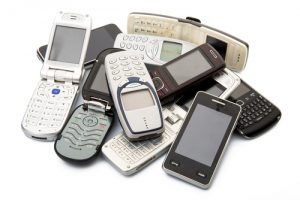 Getting old mobile devices out of Canadians’ junk drawers and into the recycling stream may be a lucrative challenge for the e-scrap industry, a survey suggests.
Getting old mobile devices out of Canadians’ junk drawers and into the recycling stream may be a lucrative challenge for the e-scrap industry, a survey suggests.

 Getting old mobile devices out of Canadians’ junk drawers and into the recycling stream may be a lucrative challenge for the e-scrap industry, a survey suggests.
Getting old mobile devices out of Canadians’ junk drawers and into the recycling stream may be a lucrative challenge for the e-scrap industry, a survey suggests.
 Bankruptcies are a fact of the business world, and the electronics recycling sector is no exception. In the wake of last week’s news that PCCR had filed for Chapter 7, we offer a timeline of significant cases that have hit e-scrap of late.
Bankruptcies are a fact of the business world, and the electronics recycling sector is no exception. In the wake of last week’s news that PCCR had filed for Chapter 7, we offer a timeline of significant cases that have hit e-scrap of late.
 The e-scrap export criminal case involving Colorado’s Executive Recycling has seen recent developments after being tied up in appeals for the past four years.
The e-scrap export criminal case involving Colorado’s Executive Recycling has seen recent developments after being tied up in appeals for the past four years.
 Environmental officials in Minnesota are still attempting to get MPC, once one of the largest electronics recycling companies in the Upper Midwest, to complete the cleanup of its former operation.
Environmental officials in Minnesota are still attempting to get MPC, once one of the largest electronics recycling companies in the Upper Midwest, to complete the cleanup of its former operation.
Ark-La-Tex Shredding Company of Tyler, Texas; Bayaud Enterprises of Denver; Commodity Resource & Environmental Inc. of Mojave, Calif.; Green Country Shredding and Recycling, Inc. of Tulsa, Okla.; Integra Certified Document Destruction LLC of Elkhart, Ind.; Record Keepers LLC of Fargo, N.D.; Safeguard Shredding LLC of Ft. Myers, Fla. SecureShredTM of Regina, Saskatchewan; The Shredder of Des Moines, Iowa; and Valley Green Shredding LLC of Westfield, Mass. have either achieved or renewed their NAID certifications for physical destruction of hard drives.
Visit our archive to view previous editions of the scorecard.
 An e-scrap facility transforms into an art gallery for an evening, and a Chinese import expert says moving recovered electronics into the country will only get tougher.
An e-scrap facility transforms into an art gallery for an evening, and a Chinese import expert says moving recovered electronics into the country will only get tougher.
Continue Reading
 Computer giant Dell says it is closing in on its goal of collecting 2 billion pounds of used electronics by 2020.
Computer giant Dell says it is closing in on its goal of collecting 2 billion pounds of used electronics by 2020.
 It’s been a little over a year since repair group iFixit and processor ERI teamed up to recover components from used electronics. And thus far, the effort has been successful in getting much-needed items out to the repair community.
It’s been a little over a year since repair group iFixit and processor ERI teamed up to recover components from used electronics. And thus far, the effort has been successful in getting much-needed items out to the repair community.
A researcher in China says that 88 percent of the blood samples taken from children in Guiyu, China clearly show lead poisoning. The findings are made more significant by their publication in the government-owned China Daily. China has, until recently, downplayed reports of Guiyu’s e-waste hazards. Continue Reading
With an air pollution permit in place for a New York operation, a U.K.-based CRT glass recycling firm says it’s bringing its smelting technology to the U.S.
